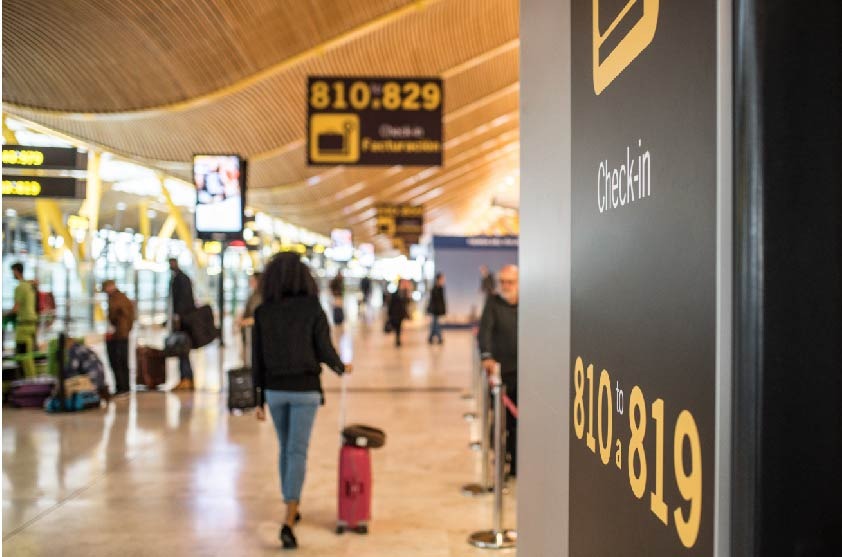To cope with burdensome airport security checks, airports are implementing innovative technologies to make passing through security easier and safer for passengers.
According to the International Air Transport Association (IATA), the APAC region was expected to see an additional 2.1 billion air passengers by the close of 2036. The corresponding growth in the airport security systems market is projected to be 8% (CAGR) till 2025. However, time spent on security screening and boarding of passengers is increasing congestion at airports. A Covid-infected aviation sector will benefit from faster security screening; greater convenience will result in more travel. In this article we discuss trends in aviation security, including bio-security, that we expect to see at airports globally in the near future.

Risk-based approach: Airports are taking a risk-based approach towards airport screening. Risk-based screening requires enhanced screenings of passengers considered to represent a higher risk, while allowing a more seamless journey for the other, lower-risk passengers. The passenger risk-score is derived from the analysis of the passenger’s origin/ destination or their status as a passenger.
Pre-Check, a security screening programme of the US Transportation Security Administration, qualifies certain passengers considered to be low-risk to enjoy expedited screening at security checkpoints at US airports. While heavy movement of persons from one territory to another may provide cracks in the screening process due to inadequate screening measures or lack of enough passenger touch-points, most countries are in the process of implementing some of the risk-based screening to ensure easing pressure on limited airport infrastructure.
Know-your-passenger: ‘Know your passenger’ is one of the essential components of a risk-based approach to airport screening. With better system integration, passenger information (viz. passenger travel and transit details, facial scans, biometrics, etc.) are collected by departure/ transit ports and uploaded onto a shared system allowing airport security to track their movements. This allows for seamless access to passenger information, and allows airports to undertake efficient risk-based passenger screening. It is expected that in the years to come, passenger information management will become standard across all airports allowing them to benefit from the log of passengers travelling through them, as well as making it easier and less cumbersome for passengers during the security screening process.
Biometric and AI: In addition to a risk-based approach, airports are also using artificial intelligence to ensure smooth and efficient passenger screening. Availability of reliable biometric and AI based analytics solutions is increasing the effectiveness of the screening process and making it faster. The market for AI in the global aviation sector is expected to reach US$ 2.2 billion by 2025. At the same time continuous developments of biometrics is enabling airport to place them at multiple touch-points to be able to collect real-time data of the progress of a passenger’s journey, and to be able to immediately flag any discrepancies.
One of the most common biometric technologies being implemented at airports is facial scanning. Facial recognition cameras take a snapshot of the passenger arriving at the airport check-in counter and takes a number of measurements to build what is known as the biometric template of the passenger using complex algorithms. Then, when the passenger is at the boarding gates, another camera takes a snapshot of the passenger and tallies it with the biometric template created earlier. If the two match, then the passenger is automatically allowed to board.
While several airports in the US are already upgrading to this technology, there have also been significant debate regarding its usefulness. Facial recognition has been used predominantly for identifying criminals. The Federal Bureau of Investigation in the US is estimated to have a facial recognition datebase of over 412 million facial images. While most consumer-level facial recognition (e.g. in mobile phones) do not save the facial image in an external server, those operated at airports obtain facial data from central servers and databases maintained by government agencies. There is an argument that airport scanning data is being used by governments to create a greater facial database of non-criminals, and it may be used subsequently for unwarranted surveillance of the general public.
Facial recognition technology has also been found to be at times unreliable. The current technology is not as reliable in identifying persons of colour and women (on account of lack of diversity in training data). Even growing or removing a beard can affect the way a facial recognition system identifies a person. Some experts also argue that facial recognition technology is not concerned with security screening, as the same is already conducted by human and machines at the airport. Their argument stems from the fact that a few airlines that do use facial recognition use it primarily as a means of easing passenger boarding to flights – where passengers can scan their face on a camera and be allowed past the boarding gates after having automatically proven their identity using the technology.
Some see facial recognition as more of a security feature than mere convenience. This technology is particularly finding favour with immigration authorities. Linking immigration enforcement to domestic security, governments are pushing ahead with implementing facial recognition at exit ports to ensure that the persons have actually left the country.
Other biometric devices viz. fingerprint scanners, iris scanners are also used to ensure passenger identification, thereby enhancing the security at airports, and the safety of the passengers in general.
Airports are also investing in artificial intelligence (AI) to determine risk when it comes to passengers and their baggage. Several US airports are experimenting with computed tomography luggage scanners to quickly and safely scan baggage to ensure safety. AI uses information gathered from scans to determine if a content of a baggage is suspicious and flags the same. This reduces the need for airport personnel to check each bag manually.
This passenger data, collected from across airports, and over a period of time forms part of a massive data bank that is constantly being churned by AI to analyse the risks that a particular passenger may pose. This data can enable a low-risk passenger move easily through security without having to take out their laptops, or remove their shoes, belts etc.
Newer technologies are using a combination of camera, facial recognition, and millimetre-wave technology to scan passengers; and machine learning is used to automatically determine threats from explosive, firearms, sharp objects, while ignoring non-dangerous items such as keys. Faster computing is enabling the movement of greater number of passengers through the security checkpoints. In fact, airports can now pass nearly 900 passengers through facial recognition and AI based scanners, a number that is significantly higher than those of conventional x-ray scanners.
Data collected during this process is used to further teach the machine to identify threats, and to ignore non-risk items.
Off-site passenger handling: Airports are also implementing off-site passenger handling, and using passenger data and AI to ensure passengers can check in themselves, pass through security, as well as through boarding gates/ immigration without any human intervention. According to IATA nearly 58% of passengers globally have used automated immigration gates in 2017.
A layered approach to Biosecurity: The COVID-19 crisis has presented a novel security risk for air travellers. The flow of contagion from one person to another in rapid progression has brought the global economy to a halt and endangered the survival of several carriers worldwide. The IATA recommends that all measures undertaken in this regard should be outcome-based and supported by scientific evidence, and undertaken by a robust risk-based approach to passenger screening. Passenger health screening should be undertaken as upstream as possible to lower downstream transmission risk. Also, any preventive measures should be applied at the departure airport, rather than at the arrival airport to ensure minimal exposure to risk by passengers. However IATA recommends that the bio-security measures should be in place for only as long as necessary, and all measures should be re-evaluated at fixed intervals to determine their efficacy in preventing the spread of a contagion. Collaboration between governmental agencies and the aviation industry as a whole is also of vital importance.
Typical bio-security measures include passenger contact-tracing to be recorded in electronic format, with information collected during visa application (for e-visa regime); airport terminals to be restricted to passengers and airport workers; passenger to be temperature-screened at airport entry; Physical distancing, use of PPE and masks, and appropriate sanitising of airport surfaces to be undertaken. IATA also recommends orderly boarding at the gates to ensure that physical distancing is maintained among passengers
Conclusion: Advanced scanning techniques coupled with assimilation of vast amount of passenger data and AI is making security implementation easier for airports, and ensuring that passengers can travel more comfortably. A risk-based approach is becoming the cornerstone to airport security. The COVID-19 pandemic has made it more important than ever to relook at security practices – faster security checks will not only reduce congestion and therefore, the risk of airports becoming hubs for spread of contagious diseases, but also increase air travel and give a shot in the arm to the ailing sector.
This post has been authored by Sayanhya Roy, Principal Associate and Anirudh Rastogi, Managing Partner at Ikigai Law, with inputs from Ujjwal Bakshi, Manager – Industry Relations at International Air Transport Association (IATA).
For more on the topic, please feel free to reach out to us at contact@ikigailaw.com
Disclaimer: This article is meant for general informational purpose only and is not a substitute for professional legal advice. This article is based on the laws applicable in India as on the date of publication.









